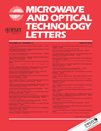Fiber bragg grating current sensor based on birefringence effect
Abstract
A novel DC current sensor configuration by combining the sensing theory of fiber Bragg grating (FBG) with the birefringence effect is proposed.Electromagnet force will occur when the measured current is applied due to the sensor configuration of a magnetic coil and a permanent magnet. A sensing FBG and a supporting fiber with the same diameter and material are inserted between two glass sheets. The electromagnet force will act on the glass sheets, resulting in a radial load on the sensing FBG. This transverse load will lead to the birefringence effect because of the different strain or refractive index variation of the two orthogonal axes of the sensing fiber. Thus, two orthogonal polarization modes will be reflected by the sensing FBG with different wavelengths. The theoretical model between Bragg wavelength shifts versus the applied current is derived. Preliminary experiments and simulation results show that current measurement sensitivity can reach 2 nm/A, and measurement resolution is about 0.5 mA. Cross-sensitivity of temperature can be compensated by the differential method. © 2012 Wiley Periodicals, Inc. Microwave Opt Technol Lett 54:822–826, 2012; View this article online at wileyonlinelibrary.com. DOI 10.1002/mop.26609




